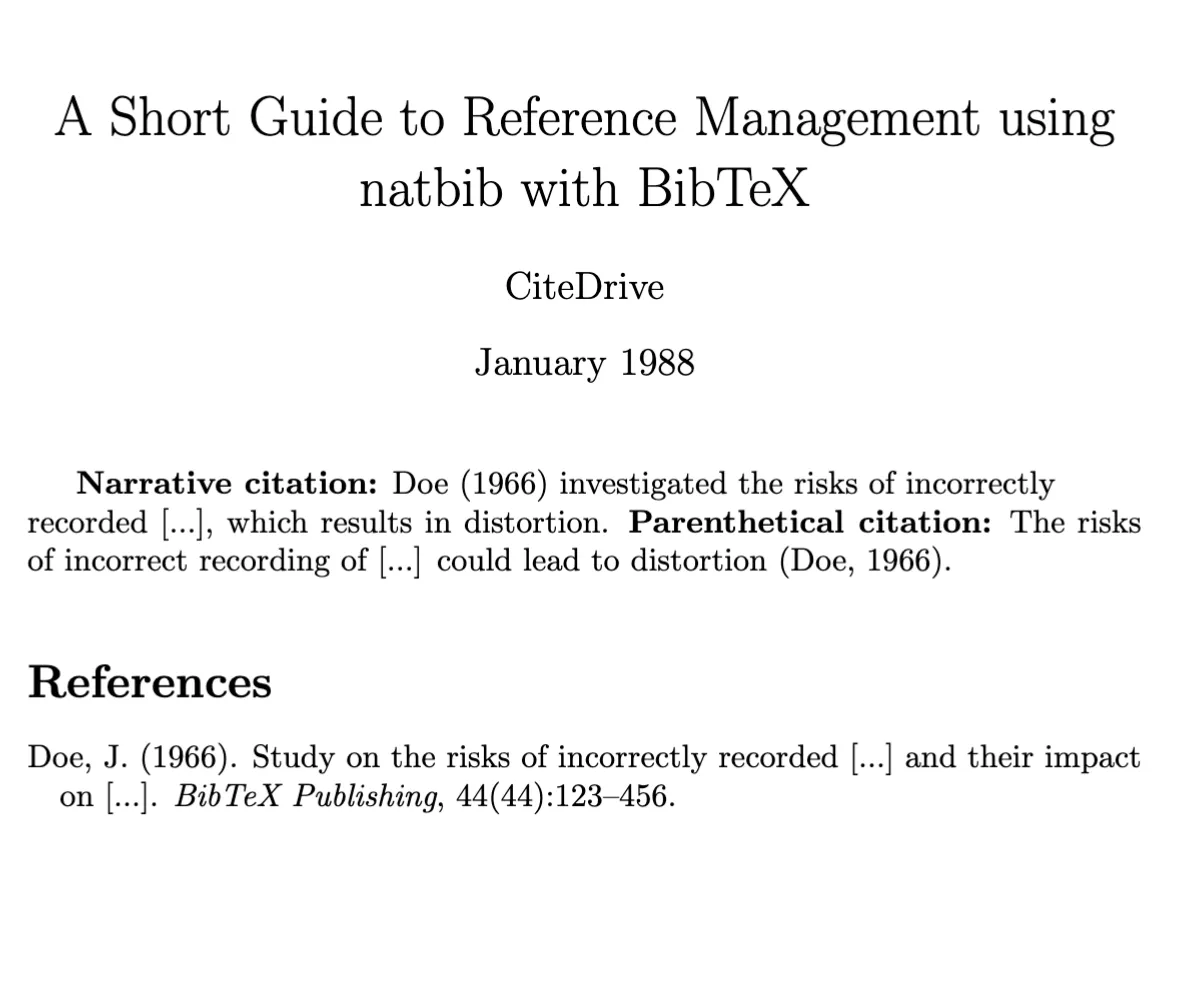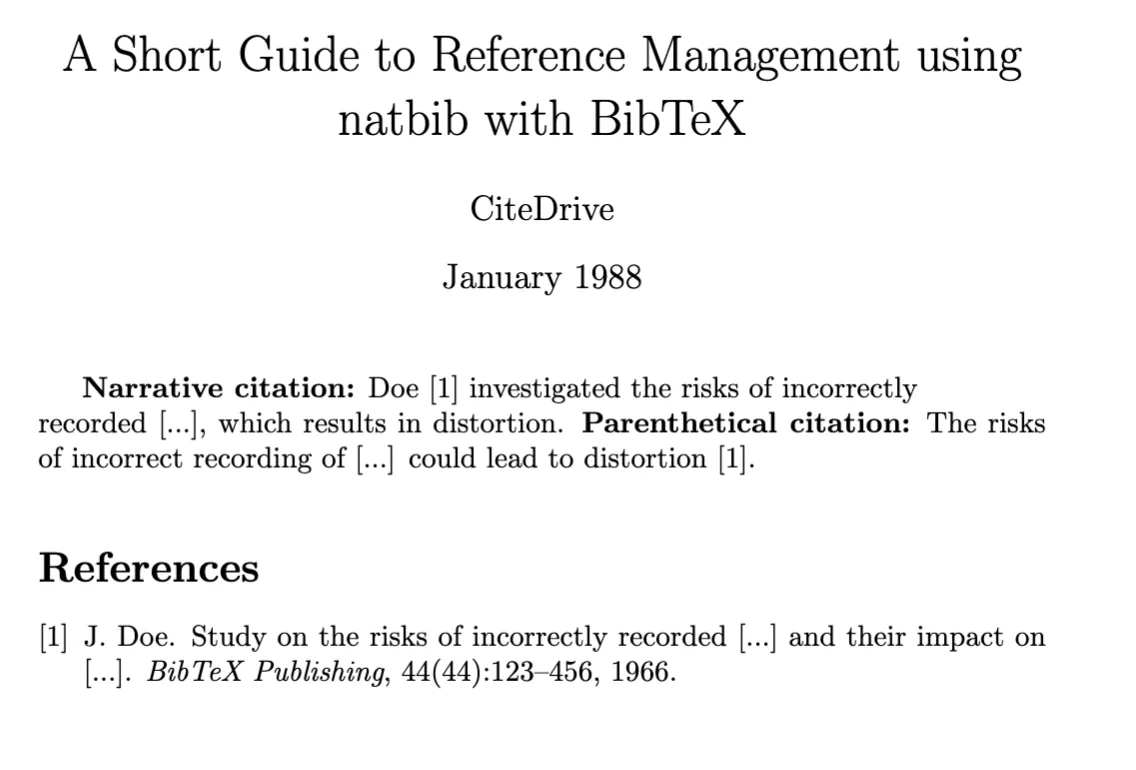Учебник по Natbib: Осваиваем управление ссылками в LaTeX с помощью BibTeX
Управление библиографическими ссылками в LaTeX становится простым и эффективным с пакетом natbib. Независимо от того, используете ли вы традиционную команду \cite{*} или углубляетесь в сложные методы цитирования, этот учебник предоставляет основные сведения для начала работы.
Введение в natbib и его преимущества
Пакет natbib расширяет возможности стандартной команды \cite{*} в LaTeX. Он особенно полезен для внутритекстовых цитат, предлагая различные варианты и настройки, особенно для схем автор-год и отображения текстовых и скобочных цитат при интеграции с BibTeX.
Давайте подробнее рассмотрим, как использовать возможности natbib для форматирования и цитирования ваших библиографических источников.
Начало работы: скобочные и текстовые/нарративные внутритекстовые цитаты с помощью natbib
Настройка natbib требует структуры, аналогичной стандартной настройке LaTeX. Начните с загрузки библиотеки с помощью \usepackage{natbib}. Библиотека предлагает несколько вариантов конфигурации через \usepackage[options]{natbib}, которые будут подробно рассмотрены ниже. Основные команды цитирования в Natbib — это \citet{*} для текстовых/нарративных цитат и \citep{*} для скобочных цитат.
\documentclass{article}\usepackage{natbib}\bibliographystyle{apalike}\title{Полное руководство по управлению ссылками с использованием natbib и BibTeX}\author{CiteDrive}\date {Январь 1988}
\begin{document}
\maketitle\textbf{Нарративная цитата:} \citet{Doe:1966} исследовал риски неверно \\записанных [...], что приводит к искажению.\textbf{Скобочная цитата:} Риски неверной записи [...] могут привести к искажению\citep{Doe:1966}.
\medskip
\bibliography{sample}
\end{document}Используя \bibliography{sample}, вы указываете LaTeX на ваш .bib-файл, который содержит библиографические записи, например:
@article{Doe:1966, title = {Исследование рисков неверно записанных [...] и их влияния на [...].}, author = {Джон Доу}, year = 1966, journal = {Издательство BibTeX}, volume = 44, number = 44, pages = {123--456}}@article{smith2017, title = {Интересная статья}, author = {Джон Смит}, year = {2017}, journal = {Журнал интересных статей}} Пример вывода управления ссылками с использованием natbib и BibTeX
Пример вывода управления ссылками с использованием natbib и BibTeX
Для тех, кто предпочитает числовые стили цитирования, вот как адаптировать natbib:
\usepackage[square,numbers]{natbib}\bibliographystyle{abbrvnat} Пример вывода управления ссылками с использованием natbib и BibTeX в числовом стиле
Пример вывода управления ссылками с использованием natbib и BibTeX в числовом стиле
Глубокое погружение: исследование команд cite{*} в natbib
Понимание множества команд cite{*}, предоставляемых natbib, позволяет эффективно цитировать источники. В этой таблице представлены их результаты:
| Команда (одиночная цитата) | Вывод (автор-год) | Вывод (числовой) | Команда (множество цитат) | Вывод (автор-год) | Вывод (числовой) |
|---|---|---|---|---|---|
\citet{Doe:1966} | Доу (1966) | Доу [1] | \citet{Doe:1966,smith2017} | Доу (1966); Смит (2017) | Доу [1], Смит [2] |
\citet[chap.~4]{Doe:1966} | Доу (1966, гл. 4) | Доу [1, гл. 4] | \citet[chap.~4]{Doe:1966,smith2017} | Доу (1966); Смит (2017, гл. 4) | Доу [1], Смит [2, гл. 4] |
\citep{Doe:1966} | (Доу, 1966) | [1] | \citep{Doe:1966,smith2017} | (Доу, 1966; Смит, 2017) | [1, 2] |
\citep[chap.~4]{Doe:1966} | (Доу, 1966, гл. 4) | [1, гл. 4] | \citep[chap.~4]{Doe:1966,smith2017} | (Доу, 1966; Смит, 2017, гл. 4) | [1, 2, гл. 4] |
\citep[see][]{Doe:1966} | (см. Доу, 1966) | [см. 1] | \citep[see][]{Doe:1966,smith2017} | (см. Доу, 1966; Смит, 2017) | [см. 1, 2] |
\citep[see][chap.~4]{Doe:1966} | (см. Доу, 1966, гл. 4) | [см. 1, гл. 4] | \citep[see][chap.~4]{Doe:1966,smith2017} | (см. Доу, 1966; Смит, 2017, гл. 4) | [см. 1, 2, гл. 4] |
\citet*{Doe:1966} | Доу (1966) | Доу [1] | \citet*{Doe:1966,smith2017} | Доу (1966); Смит (2017) | Доу [1], Смит [2] |
\citep*{Doe:1966} | (Доу, 1966) | [1] | \citep*{Doe:1966,smith2017} | (Доу, 1966; Смит, 2017) | [1, 2] |
Другие команды natbib, такие как \citealp и \citealt, предлагают дополнительную гибкость, исключая скобки. Ознакомьтесь с полным списком команд в Таблице справочных материалов по использованию natbib.
Приложение: Осваиваем параметры для natbib
Работа с natbib и настройка его поведения может значительно упростить ваш процесс работы. Вот краткое описание доступных параметров через \usepackage[options]{natbib}:
| Параметр | Описание |
|---|---|
| round | отображает круглые скобки |
| square | отображает квадратные скобки |
| curly | отображает фигурные скобки |
| angle | отображает угловые скобки |
| semicolon | множество цитат разделяются точкой с запятой |
| colon | аналогично точке с запятой |
| comma | множество цитат разделяются запятой |
| authoryear | отображает цитаты в формате автор-год |
| numbers | отображает числовые цитаты |
| super | отображает номера в верхнем индексе для числовых цитат |
| sort | сортирует несколько цитат в порядке их появления в библиографии |
| compress | сжимает сортированные числовые цитаты по мере необходимости |
| sort&compress | сжимает несколько числовых цитат, где это возможно |
| longnamesfirst | полное имя автора отображается в первой цитате |
| sectionbib | переопределяет \thebibliography |
в разделах|
Для получения дополнительной информации посетите официальную документацию natbib.
Заключение
Пакет natbib в LaTeX является мощным инструментом для управления ссылками. В этом учебнике мы рассмотрели основные функции natbib, включая скобочные и текстовые цитаты, параметры и команды для улучшения управления библиографией, а также вывод в числовом формате. Этот инструмент значительно ускоряет работу с научными статьями и другими типами документов.